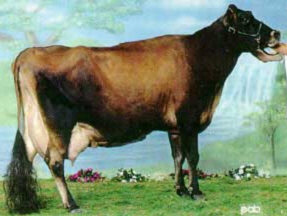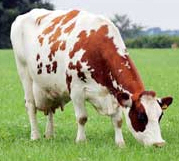



Canadienne
History
Canadienne cattle were developed in Canada primarily from animals imported from Normandy and Brittany during the 16th and 17th century. This stock was blended on this continent and selected for hardiness and productivity in the New World. The first regular importations of cattle into Canada were in 1608-1610 from Normandy in France. Later importations came from Brittany and Gascony. The population remained largely closed to other breeds and eventually became known as the Canadienne. Photo courtesy of www.ansi.okstate.edu |
Canadienne Cattle have made a comeback today and are known as Black Canadians, Black Jerseys, Canadians, or French Canadians.
Characteristics
The Canadienne is small (cows weigh 1000-1100 pounds) about four and half foot tall, long-lived and has an exceptionally docile temperament. They are born pale, then become black or dark brown, often with paler muzzle, side, and udder or scrotum. There may occasionally be white on the udder, stomach and chest. Canadienne also have very darkly pigmented skin and dark hooves. Their horns are quite short and their straight faces are refined, tidy.Canadiennes produce good quantities of milk in relation to their own body size and food requirements. The meat tends to be lean, and the light bone results in a high percentage of usable meat in relation to total body weight. A cow annually produces about 3800 kg of 4.4% butterfat, 3.6% protein milk.
An extremely rare breed, the Canadienne breed of cattle is well known in Quebec and are very well suited to Canada's cold climate.
Statistics
- Very hardy cattle
- Adapts well to many dairy management systems
- They will thrive in pasture rather than on expensive imported grain
- Production of quality milk in quantity compared to body size
Comparative
Distribution
This breed is mainly limited to Quebec in Canada and is still quite rare although they are making a comeback.References (the above information was cited from the following sites)
www.ansi.okstate.edu


